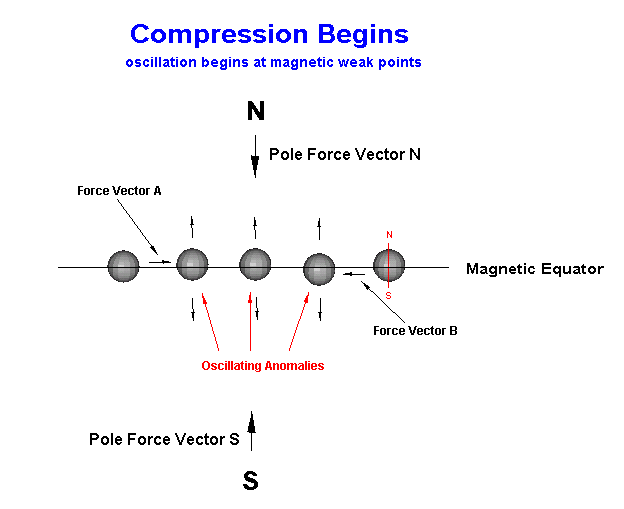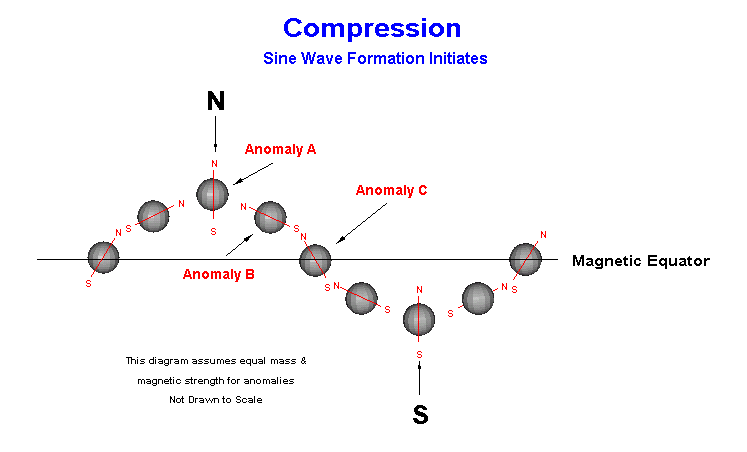Magnetic Stars
Rebuttal
to Max Planck Institute
Primary Draft version 4.6
not completed
Topics Covered:
Fossil
Field Theory
Dynamo
Theory
Amplified
Magnetic Particle Flow
White
Dwarf Accretion
Creation
of Nebulas
Creation
of Stellar Masses
Collapsing
Nebula Clouds
Written Oct. -Dec. 2005
A press release dated October 14, 2004 states that the puzzle of magnetic
stars has been solved by the prestigious Max Planck Society, full article
reprinted below, but is this explanation proposing a solution or associating
current theories that might fit observations? Examination of the press release immediately
refers to special situations of how some white dwarfs and neutron stars are
highly magnetic, but what is the process that separates the 2 classes of stellar
objects from others. The theory proposes how a magnetic field is
assimilated into a stellar object by the "fossil field hypothesis", and
that gaseous nebula cloud holds remnant magnetic fields. According
to their own words in the press release, "This demonstrated that two criteria would need to be
fulfilled for the fossil theory to be viable."
First we need to look at the special situations, in which the field of
astrophysics seems to always have an answer for. How quick is a hypothesis submitted that explains only a
facet of an observation while the supplement of related events that does not
coincide with the new theory goes unexplained? In the case of
the white dwarf, one must ask does a certain type of nebula contain higher particle concentrations
related to the creation of an ambient magnetic field? For insight into nebulas lets examine mankind's
definition proposed by the University of Arizona.
Mankind's Definition of a Nebula
Courtesy
of the University of Arizona
Diffuse nebulae, sometimes inaccurately referred to as gaseous nebulae, are
clouds of interstellar matter, namely thin but widespread agglomerations of gas
and dust. If they are large and massive enough they are frequently places of
star formation, thus generating big associations or clusters
of stars. Some of the young stars are often very massive and so hot that
their high energy radiation can excite the gas of the nebula (mostly hydrogene)
to shine; such nebula is called emission nebula. If the stars are not hot
enough, their light is reflected by the dust and can be seen as white or bluish
reflection nebula. Note that many emission nebulae also have an additional
reflection nebula component (as they usually also contain dust); a most
impressive example for this is the
Trifid
Nebula M20.
Diffuse emission nebulae are often called H II regions because they are
mainly consisted of ionized hydrogene, H II - the roman number after the element
symbol (here H) designating the ionization level: `I' would stand for neutral
atoms, the `II' here means first ionization, i.e. the hydrogene atoms have lost
their single electron, and for other elements higher numbers (ionization levels,
or numbers of lost electrons) would be possible (e.g., He III, O III or Fe V).
After some million years, the gas and dust of the nebula will have been
used up for forming stars (and planets), or blown away by the stellar winds of
the young hot stars. A newly born open
star cluster will remain. From the physical viewpoint, the nebulae are an
early stage of evolution of star clusters.
Source http://seds.lpl.arizona.edu/messier/diffuse.html
Addressing the Fossil Field Hypothesis:
Current theories state magnetic properties do not survive above the
curie temperature,
if so hydrogen plasma residing in present day nebula could not retain an organized
magnetic field over time to be absorbed by new forming stellar objects as stated
by the ‘fossil field’ hypothesis. The basis for the Max
Planck Institute's theory is retention of a magnetic field while hydrogen is in
a plasma state. It is here mankind's goes astray by stating ferromagnetic
properties apply only to solids, but in the same breath use the same properties for preservation of a magnetic
field over time. The reason why magnetic properties are
lost above the curie temperature is due to molecular agitation a factor still
present in plasma to a greater degree as by product of heat. Decay of a magnetic field alignment within a nebula as the
temperature and time was never taken into consideration. For those who may consider a
current or a charge maintaining an organized flow in a gas cloud, ponder this, what
centralized force would control a closed loop circulation? Movement of electrons
released by hydrogen ions could explain a source for a magnetic field emanating from a nebula, but
observations of the gas clouds show little organized torroidal motion and
convection about the conventional loop. A magnetic field is maintained in a stellar object by motion
underneath the surface of the star, but mechanics of this process is only
vaguely true with mankind's attempt to explain the
creation of this field by presenting the dynamo theory.
Does an ionized field of gas in an nebula exhibit organized magnetic fields,
no, how can ions opposed to each other with like charges all trying to achieve
equilibrium thru expansion into the void of space come together? Would a
concentrated volume of hydrogen plasma come together and form a mass in the cold
void of space or would the momentum of expansion due to pressure differentials
overcome the weak gravitational force?
Some stars of spectral type A (the
`Ap stars') are observed to have a strong
(300 to 30000 Gauss) static and large-scale magnetic field, of a chiefly dipolar
shape. In one explanation this field is being continually regenerated by a
dynamo process in the star's convective core. In another, the field is a remnant
of the star's formation, a `fossil field'. These hypotheses have been competing
since the discovery of magnetic stars half a century ago. The dynamo hypothesis
has difficulty explaining the high strength of the fields observed. The main
weakness of the fossil-field theory has been the lack of known field
configurations which are stable enough to survive in a star for the whole of its
lifetime. We demonstrate here the existence and formation of such stable
magnetic fields, thus providing a solid basis for the fossil-field hypothesis.
The results also apply to magnetic white dwarfs and a group of highly magnetized
neutron stars known as magnetars.
From a seminar sponsored by Canadian Institute for Theoretical Astrophysics
http://www.cita.utoronto.ca/index.php/events_calendar/origin_of_the_stable_magnetic_fields_of_a_stars_white_dwarfs_and_magnetars
Can we apply the dynamo theory to compensate
for any differentials in the ‘fossil field’ hypothesis when pertaining
to white dwarfs?
In a white dwarf, the upper portion of the solar mass sphere, vertical convection is limited due to
gravitational compression thus constricting motion, which is a basis for the dynamo theory to work.
Mankind assumes a white
dwarf has no way to
accumulate hydrogen mass to maintain a fusion process
unless it is accreting (Accumulation of dust, gas or matter onto larger bodies such as stars, planets and
moons) matter from a nearby star. One must consider why would vast quantities of mass would leave a stellar object due to gravity, would
not the whole mass plunge as a unit since fringe gases susceptible to being stripped would
not fuel a white
dwarf? Lets examine a binary stellar companion scenario and the accretion of stellar
mass from the minor partner. Current theories does not take into account
the before and after mass to gravitational - distance ratio between the 2
stellar objects that were in orbital equilibrium before the collapse of the
white dwarf. A distance that increases only by the reduction in the primary star
radius vs. an exponential increase in gravitational force. The increase of radius
of the minor binary stellar object and the shrinking to a white dwarf is small in comparison to the increase of
concentrated gravitational force now present between the 2 objects. What should be considered is that any gravitational source capable of
ripping away mass from the upper levels of a stellar object will in essence
assimilate the entire minor binary stellar object, which would occur in all
variations of this model.
|
In this illustration from NASA, the
binary companion to the white dwarf has stellar matter being ripped away
by a gravitational stream binding the 2 objects. This scenario would
only be possible if the minor object maintained its orbital distance by
a repulsion force. Thus matter can be transferred as the orbit is
maintained,
but total assimilation by the increased gravitational focus at the
closest point is prevented. This of course would be counter to Newton's
Second Law of Motion. Also no explanation is given for the uniform
expansion along the equator when the far side should be compressed due
to the gravity of the white dwarf, but this is just an illustration.
|
|
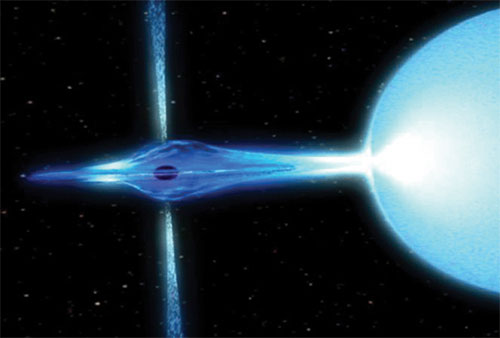 |
|
|
Illustration Credit:
constellation.gsfc.nasa.gov |
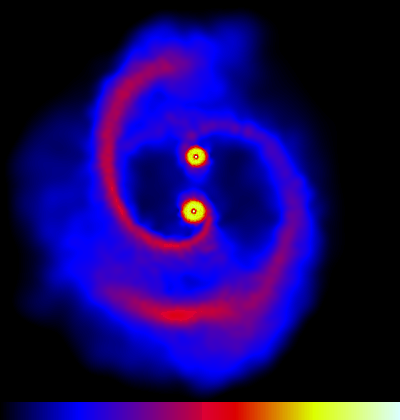 |
|
A Neutron Star with it's
intensified gravitational field generated by compression of the stellar
mass would capture the binary companion instead of slow
accretion. Would not the system be subject to new force to mass ratios
as the as the gravity would overwhelm established equilibrium based on
distance that keep
the stars in rotational balance?
|
| Illustration Credit: http://www.astro.ex.ac.uk |
|
|
Is there another source responsible for the magnetic field like within a
nebula? Theoretically mankind can not find
vast amounts of matter in the universe to explain their gravitational observations, dark cosmic
masses with high concentrations of iron, low reflectivity and little to no energy signatures would be below detection of our best
instruments. This would provide a basis for these rogue fields. Although some consider the initial nebula a source for the magnetic fields of magnetic stars.
So what factors should be considered? What binds the
remnant magnetic field if hydrogen ions
with the same charge are expanding from a high pressure area to one of low density the
colder regions of the universe? Would not there be a magnetic repulsion force on the atomic level as ions
resist consolidation due to a like positive charge overwhelming the weaker binding force of gravity?
Could condensation gather a gaseous nebula cloud as low pressure voids spins
ionized hydrogen atoms inward to the central pint or eye of low pressure as heat
radiates out into the cold depths of space? Mankind must realize that a field does not
just exist or preexist on a grand scale, but is created by movement of electron related
charged particles released
predominately by hydrogen atoms as they move about an object's core in an ionized state.
A nebula (definition)
is a cloud of gas where the expansion rate is contained initially by pressure
wall created by a violent or rapid expansion of gas and over time by a collection
of random collection of masses held about a common iron based gravitational center
otherwise dissipation would occur. What is confusing to astronomers is the
concept of a stellar nursery. Mankind is not privy to the whole sequence of
events of stellar formation after the Big Bang. That some remnant gas clouds
wharfing near
cosmic objects are the by product of stellar formation and the gas was not
captured by a cosmic mass that was initializing shortly after the big bang and
its consolidation process is blown outward when the star lights due to gravitational
compression. As objects coalesce out of the gas clouds shortly after a big
bang do you expect that all nebula gas is utilized? No, that which is not
captured dissipates out from the newly formed solar winds about and hovers about
the dominating common gravitational center. Any magnetic field of ultra strength is one where particles of magnetism are
flowing incoherent streams as opposed to a diffused bundle as diagrams from the Max Planck
Institute below illustrate.
One thing that mankind has learned about particle movement and its resultant
wave format is any concentration of fields or particles are due to cooperation.
With lasers the wave patterns of light particles are coherent as all reinforce
each other. A mega magnetic field that develops in a neutron star or white dwarf
is different as source of magnetic sub atomic particles that hover near the basic atomic
structure of the core not only stack within the same exit and entry channels,
but also becomes coherent with overall particle
movement. Gravity
inhibits particle movement at the core only as the movement of many streams come
into unison is the force great enough to leave the comic object in a violent
particle ejection thru a constricted polar channel. In the core
many random sequences happen by chance when synchronization magnetic particles
flow streams does not occur all
magnetically related sub-atomic particles fall back into and around the core to
organize again.
Mega magnetic fields occur where core has sufficient iron to provide a base of
magnetic particles to initiate flow, gravitational constriction of the core to
provide rapid synchronization and bursts of particle streams, but allow for buildup
providing amplification of the field.
Nebula that are
created by stellar objects are the result of their internal explosions of gases.
The factors
determining initial shape are dependent upon how stellar matter is released, bi polar, along the
equator, intermittent bleeding in random areas or stable release points that slide between the
pole and equator while rotation is involved. During the expansion phase
gravitational forces from nearby cosmic objects and their solar wind are now the
primary factors concerning shape.
|
Dark matter, the atmosphere of outer
space in this universe and density plane is a near vacuum compared to our blanket of air that surrounds our
planet is compressed at the leading edge of a Big bang localized
explosion. Being that, the dampening field, dark matter is uniform before
initialization of a new galaxy or cluster The leading edge of the
ionized gas takes the form of a bubble as seen in some of your photos in
the universe. A nature formation created as gas presses outwards against a
uniform dark matter field under compression in what is though as a total
vacuum.
|
|
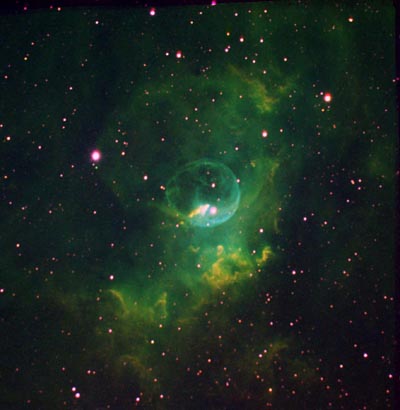 |
As a nebula expands forces that determined its shape and
formation are no longer present and some cases the external patterns of
formation may not resemble the uniform interior structure as containment factors
and gravitational sources change from the point of origin.
Stellar Formation
How would a stellar object form? After a localized big bang,
clumps of matter varying in size from massive rivaling small stars to molecules
the precursor to interstellar dust would expand rapidly into what seems a total vacuum. Mankind does not realize that there are other particles in space that
determine expansion of matter. Ask yourself what force is necessary to reverse
the expansion of ionized gases expanding out of a big bang? Mankind has never
witness the birth of a star yet some have witnessed stellar death, a super nova.
If one was to experiment with a vacuum could a
coulomb charge attraction similar to what is present in today's assumed stellar
nurseries, gravity or just condensation due to lost of
heat overcome this force of separation of particles to form a new cosmic mass? Does not decompression rip almost all objects from
within a plane with air pressure differentials that are just 30 thousand feet
above the surface of the Earth? Would not a catastrophic leak in the space station rip apart its
interior? So how do you think a star would form in the vacuum of space by
accretion or condensation of a gaseous cloud? What force would
gather ionized hydrogen atoms? Certainly not your weak force of gravity or even charged particles as most hydrogen atoms stripped of an electron would take on
repulsive like charges.
So what is the process of stellar formation
after a localized Big Bang occurs in a sector of the universe?
The idea of the "Big Crunch" in that
it is correct that there is a compression phase after a "Big Bang",
but these sequence of events are on a local level with gravity orchestrating
actions via centralized galactic black hole, which gathers all available matter
within range of initial existing galaxy. The processes that occur in the capture
and expulsion of matter within a Black Holes is covered in more detail in this paper.
Once the localize Big Bang occurs the expanding blast wave produces a
secondary effect. What is seen as the surface of the expansion bubble is
now being dampened by the build up dark matter and galactic
repulsion particles at the expansion edges. This action sets up an opposite
and equal reaction as the subsequent waves, echo compression waves are reflected
back towards the original point of the Black Hole expansion. Thus initiating
random condensation points within the sphere of expansion. Light elements the
first to expand outward are forced back permeating the slower moving fluid heavy mass propelled by
the blast initiated from the compressed remnants captured
of galactic mass by the
dominant black hole into the low density environment of the universe. Light
elemental gases of super ionized gas would then inflate pockets inside heavy matter
thus stretching and thinning the containment perimeter of heavy matter. Examining a microcosm of
these events, globules of heavy matter laced with a
lattice of honeycomb hydrogen ions or other light elements once cemented
together then collapse due to cooling or compression as pressurized containers
of light matter transfers most of
their heat content to the surrounding matter.
With a higher surface to mass ratio dissipation its latent heat content disperses
quickly into the depths of space and cools, in essence the heavy matter becomes a heat sink. Do you not see this same
process occur during volcanic explosions as trace rocks left of the event are
frozen in the form of pumice. A collapse or compression of the pliable matter occurs
due to overall thermal reductions of the mass surrounding the light elements, thus shrinking the
containment perimeter. The heat and gaseous expulsions pressurizes the immediate
area surrounding the mass once heat is absorbed pressures fall in the spaces
between clusters of masses. This creates a temporary low pressure zone near the surface
of the mass, resulting in the capture of more minor globules of matter being sucked in
to fill the void with gravity assisting capture at extreme close proximity
of the dominant mass or temporary gravitational center. As assimilation progresses into the greater mass, reduction of the temperature
of the surface perimeter of the primary mass is further reduced, thus a chain
reaction starts. A cycle of a primary shrinking mass, which creates
a pressure void in near spatial bubble edge zone (
the temporary spherical shell of lower pressure that forms around the surface of
a mass due to
void left by compression, which shrinks in volume quickly as the heat content
dissipates into space while pressures of the ambient dark matter field pushes
back for containment) , the
cascading affect is attraction of smaller masses, with the resultant growth of
the primary and the cycle repeats . As random mass
are captured along the surface momentum of the object assimilated on the surface
provide a torque, which is accelerated by condensation increasing the relative
spin of the newly formed cosmic object, thus reinforced as parts of the mass are
attracted to nearby objects and then overshoot adding momentum to the spin of
the object. Once thermal emission no longer supports compression of the
primary mass and gravity gathers and holds the containment of most matter from dissipating
into the near vacuum of space. The object essentially gathers all mass within the area until surface
pressure differential and gravity can no longer attract mass away from the
nearest cosmic object. and the cutoff of cooling light elements. the matter would cool as
heat and energy dissipates into space pressure voids attracts mass until
sufficient matter is gather to invoke gravitational attraction of lighter
elements. The key to the fusion process is the
compression of the honeycomb heavy matter is their hydrogen surrounding this
impregnated matter to provide sufficient pressure, second once compressed are
there enough pockets of fusion initiating a reaction to cause a net positive
gain of heat and light. Third is the heat and light produced overwhelm the total
mass so that it radiates.
But this process occurs in steps. Once a stellar
object gathers enough mass to initiate the fusion process in the core it heats
up the core expands and compression is no longer there to maintain a fusion
process so it sputters and shuts down until heat is transferred away, thus radiating
into space. The surfaces cools again creating another pressure void near the
surface thus attracting more
mass. Compression starts again as further condensation of the core allows hydrogen to be
stirred and random points of hydrogen nuclei fuse within the core. The stellar mass sputters through
many cycles until the mean compression pressure in the core is not displaced by the
expansion force created by the fusion process. The star's intensity is
determined by the fusion output in relation to the heat and light carrying
capacity of uniform unit of mass of the stellar object.
Collapsing Nebula Clouds
How can we gain insight into stellar formation from the
present theory of collapsing gaseous nebula clouds. Current theories of star
formation fall short in the fact that many rare stellar deaths, super novas have
been recorded by mankind, although no concrete evidence of a star birth. Present gas nebula clouds are suppose to be
collapsed by gravity, but how is
this so? A nebula cloud exists in the fact that binding force of gravity
counters the movement of hydrogen to a low density environment of space.
pressures slightly vary as currents are formed trying to achieve equalization
thus overshoots are observed as columns and cloud like puff pockets. If you observe Jupiter with its mass, can it gather the asteroid belt
with its powerful gravitational pull? The slow orbital momentum of its moons is
enough to avoid capture. so how can a cloud of gas with a pressure concentration
slightly above the near vacuum of space with its mass spread across many cubic light
years and no centralization initialize concentration or compression. The key is to consider the amount mass vs. volume.
It is here where
theories fall with no point of gravitational concentration as the hydrogen cloud
is generally equalized in pressure. If gravity is a wave how do you explain the cancellation
of waves emanating from many sources within the cloud? If gravitational compression was due
from a single source, why the distorted shapes as opposed to a bubble? Here we
examine a Numerical Simulation of a
nebula cloud with a mass 50 Suns and a diameter of 1 light year to see if the
hydrostatic equilibrium holds as its radius is collapsed in a series of factor
10 steps.
Life Cycles
The life cycle of a star does not necessarily follow a sequence, but the
star does evolves based on many factors: Mass, Availability of Fusion matter, thermal
core mixing, The light to heavy elemental core ratio, thermal conductivity of
the stellar mass due to elemental composition, total spherical area for heat
transfer. Yes it is true that stellar objects do evolve, but the initiation of a
stellar can form along most classifications of mankind's 0sequence of stars. Current theories cannot explain the recent increase of thermal and
light output from the Sun though some will say the Sun has not increased in
brightness over the last 2 years. Did gravity increase on the Sun without additional
mass? What is responsible for the increased rate of fusion without additional
compression? How is containment possible with the recent expansion of the
sphere? What about the high activity of solar flares and sun spots when we are
now at our solar minimum? None these questions can be answered under current theories.
So how can we believe this new concept of star formation without an example
in the real world? What we can do is examine the largest environment that can
support condensation of foreign gaseous matter to the ambient. One only has to look at cloud
formation as thermal content in the segment of atmosphere varying from
local to encompassing a continent decreases as the water vapor mass
contracts into a liquid, transition or solid form. Why doesn't this event cycle occur
thus morphing into one massive cloud? Mankind could learn a lot from observing nature here on earth, do you think the universe is not uniform
from the grand scale to what is seen in a microcosim here? The rules of
science and nature are uniform with few exceptions and those few exceptions for now,
which are beyond present day mankind's comprehension. As clouds are formed from
condensation what is unique that pressure drops along the surrounding edge zones and this void is
quickly filled in a complex relationship to high and low pressure temporary zones.
This is the separation factor. The current factors of the overall equilibrium of the air
mass is the primary goal. Thus many random
cloud of water vapor condensation sectors form according to the many variables
Incomplete Points
- white dwarf heat dissipation is more concentrated as overall surface area
for spatial thermal transfer is greatly reduced, so a reduced fusion process in
large mass could appear as highly elevated in a smaller spatial spherical
surface area.
- the collapse process matter condenses creating a pressure void which
hydrogen
fills condensed cooled molecules bombard the heated atmosphere of their molten
core evaporating thus removing the heat content until the surface cools
- compression leads to movement and if the stellar mass does not light a balance between the
slow movement of the core and generation of heat vs. gravitational pressure
holding the mass vs. available hydrogen and other light element plasma ions the area.
Quoting from Max
Planck from under their diagram they have run numerous simulations to explain a
tennis ball seam to describe a magnetic field of a white dwarf all but ignoring
basic theories in particle
movement.
Fig.: Shape
of the magnetic field lines in a magnetic star, computed by numerical
simulations (stereo images upper left). They form a ring of field lines
twisted around each other (blue). Field lines protruding through the
surface of the star (red) are held together and stabilized by the twisted
ring inside the star. This is illustrated by the schematic sketch (the
lower right) and the cut through the star (upper right). This magnetic
field configuration drifts slowly outward (over a period of hundreds of
millions of years) under the influence of the finite electrical
resistivity of the star, then distorts into the shape of the seam on a
tennis ball (lower left Fig. A), after which it disappears from the star.
A serpentine distribution of magnetic anomalies distributed along the surface
of a white dwarf has in theory has taken the shape of the seams of a tennis
ball. Although a relatively new observation in astrophysics, the surface format
on stellar masses can be explained. due to its dense compressed structure, and
basic particle movement to achieve a magnetic subatomic particle flow equilibrium. Magnetic anomalies
and how the mechanics of field's creation within a stellar object are still a mystery to current
science, yes science can predict effects and analyze fields, but do they understand
the secrets of how the relationship of the atom and the sub atomic particles
linked to field flow and interact? First to gasp an understanding we must introduce
new basics, the fusion
process to the scientific community, which examines the relationship between
the light elements and heavy metals primarily iron within the core. Random magnetic anomalies near
or on the surface of a white dwarf or
stellar object are not by chance, but part of an organized process creating what
seems to be chaotic surface events. As small pockets of iron plasma floating about the surface of
a dense hydrogen-helium white dwarf and each cluster responds with an individual magnetic field
to each other while aligned to the stellar poles. If one was to at the start of the process most
anomalies would gather along the magnetic equator the neutral point between the
magnetic poles. As crowding starts to occur along the magnetic equator, groups
line up side by side in a ring tend to have sections slide north and south of the neutral zone to escape the magnetic
repulsion of the tightly clustered anomalies and two factors of its placement on the surface come to light.
The relationship to other magnetic anomalies on and near the surface of the
stellar object and the overall equilibrium to the stellar poles.
Magnetic anomalies when crowded about the surface in a line begin forming the
shape of a wave with the wave's amplitude dependant upon the crowding in the now
deformed ring as the force to slide north or south
and away from each other and the strength of
the magnetic pole of the ambient object and position of the original
starting anomaly latitude. The
result is a serpentine arrangement, sine wave, which reverses
near the pole as the stellar poles tend to impede encroachment thus reversal of
the magnetic anomalies back towards the equator occurs. Thus, oscillation about the equator
is like the
seam on a tennis ball.
Phase 1:
After gravitational induced consolidation of the newly
formed white dwarf is completed in most cases the nuclear fusion process is
stepped due to core stirring, thus making isolated pockets of light element fuel
available under the exponentially increased compression due to the concentrated
flow of gravity particles.
Convection forces breakaway temporary ellipsoid bubbles
containing a mixture of light and heavy elements primarily iron plasma on the
edge of the stellar core to rise to the surface. This is no different than heavy
particles of soot being caught in a draft of fast rising hot air.
Once on the surface of a dense white dwarf the magnetic
properties of the anomaly immediately align with the poles where interference
from other anomalies floating about the surface are distant.
Free to move the anomalies now aligned seek a place way the
magnetic repulsive force affecting the polar coordinates of the anomaly are
minimal, a location that only exists along the magnetic-rotational equator. For
askew magnetic-rotational axis see Phase 3 for exceptions.
|
Initial Stage Anomaly Line up Along
the Magnetic Equator |
|

|
Phase 2:
In the second phase as more anomalies are suspended about
the surface of the white dwarf compression along the magnetic equator occurs as
each anomaly's magnetic field starts to crowd each other jeopardizing the stable
side by side alignment.
Rippling occurs among the anomalies as they pop away from
the magnetic equator into magnetic polar repulsive weak points, which limits the
oscillation in the Y direction in proportion to the factors of stellar gravity
(surface viscosity and tension on the white dwarf are sub components controlled
by gravity in the hydrogen-helium medium), rotational torque applied to the
surface anomalies, compression of adjacent surface magnetic fields due to the
volume of anomalies floating about the surface, the strength of the stellar
magnetic field and the average mass & magnetic strength of the
anomalies.
The trans formation into a small wave pattern occurs by a
random chance. As the volume of surface anomalies increase, some anomalies spend
more time away from the equatorial neutral point as the equilibrium point moves
further away from the x axis. There comes a point when several adjacent
anomalies are pushed away on the same side of the equator, thus reinforcement occurs a the first minor wave is achieved as anomalies pop out of the magnetic
equatorial plane finding equilibrium when others support its position from below
near to the crowded plane.
Phase 3:
Complete wave formation happens as a crowded surface line
forces more and more anomalies towards the poles until the number of anomalies
rising to the surface of the white dwarf is offset by the number falling thus
maximizing the amplitude of the sine wave formation. Thus the magnetic repulsive
force from the polar regions establish an equilibrium with the halt in the Y
direction of the wave form of anomalies pushing up from the magnetic equator.
In figure 3 we can se how the interrelationships of
adjacent magnetic fields are affected in the local area while still being govern
in the wide area by the stellar magnetic field.
In the case that rotational axis and magnetic axis is
askew, upon an increase in anomalies compression would occur and a wave format
would already be initiated due to magnetic rippling as the particles y
coordinates oscillate in relationship the rotational and magnetic axis
differential.
|
IC 418: The "Spirograph"
Nebula
The texture of this nebula is still
unknown in main stream astrophysics, but there are clues here if you
look with a fresh eye.
Explanation
Below |
|
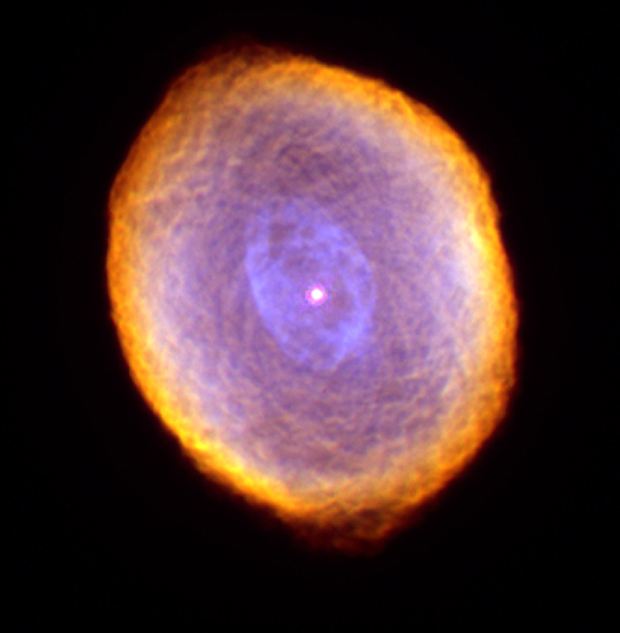 |
|
This Hubble image of IC 418 is a
false-color representation, based on Wide Field Planetary Camera 2
exposures taken in February and September, 1999 through filters that
isolate light from various chemical elements. Red shows emission from
ionized nitrogen (the coolest gas in the nebula, located furthest from
the hot nucleus), green shows emission from hydrogen, and blue traces
the emission from ionized oxygen (the hottest gas, closest to the
central star). The remarkable textures seen in the nebula are newly
revealed by the Hubble telescope, and their origin is still uncertain. |
|
Image Credit: NASA and The Hubble Heritage Team (STScI/AURA) Acknowledgment:
Dr. Raghvendra Sahai (JPL) and Dr. Arsen R. Hajian (USNO)
|
The Spirograph Nebula is unique in that several factors have to be in place
to create this pattern. First a primary heavy gravitational stellar object and a
binary low mass stellar group that orbits the primary, a triple star system. As
one of the low stellar masses ejects streams of hydrogen jets from its polar
regions a spirogragh pattern emerges as the binary stars rotate many times about
each other to the one orbit of the primary stars. The primary Stars solar wind
is responsible for the expansion with breaks in the expulsion responsible for
inner bubble. The total oval shape takes form after a long period expansion due
the wobble in the triple star system. This wobble (see figure
4) is tow tier primarily between the binary system and primary stellar
object and the minor effect is between the binary stars and their gravitation
neutral point. Tight patterns seen on the outer
edges of the nebula are replaced with a wider mess in the interior as the mass
of the of one of the binary stellar objects is reduced thus expanding the
orbital distance between the two objects about the point of mutual rotation. For
asking about the repulsion factor, it decreases at a faster rate than gravity as
the orbit expands.
|
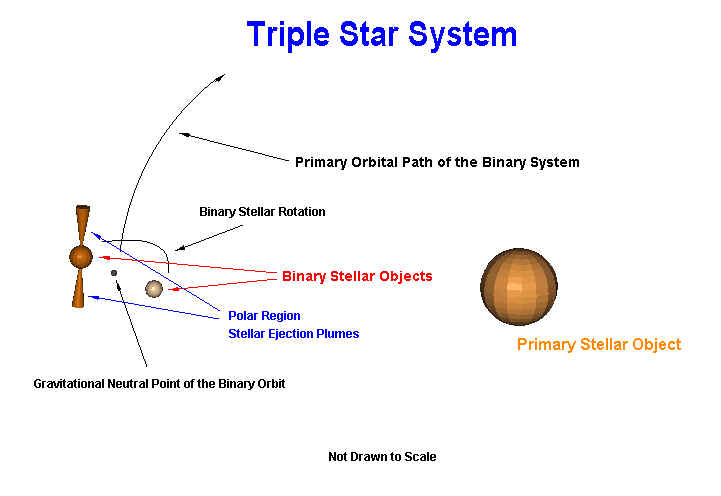
|
|
and rotation has most components of
the upper layers of the star rotating in unison.
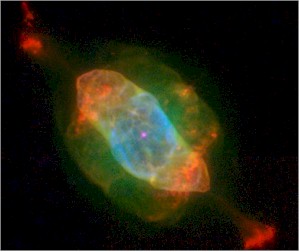 |
|
In this nebula a uniform stellar explosion initiated the
primary green bubble, secondary bipolar explosions deformed the bubble
into an oval and its orange gas, third an uniform explosion creates the
inner blue cloud and finally a concentrated high energy bi-polar
explosion rips thru the cloud with gaseous particle concentrations noted
in red expanding quickly once outside of the main nebula containment
bubble.
|
Galactic Repulsion Particles: Theses
particles are unique in the fact that it affect primarily stellar masses lit and
unlit, but follow the same principles of the common repulsion particles
affecting all cosmic objects in a solar system. The difference is in how they
are created and common point of origin. A galactic repulsion particle is unique
on how it affects mass, created in the core of Black Holes this particle rips
thru light masses such as planets, moons and other small cosmic objects. the
force is applied only the heavy mass cosmic object as it slows penetrating the
likes of stellar cores and applying force in the same direction of motion.
Questions to Consider:
How quick is a hypothesis submitted that explains only a
facet of an observation while the supplement of related events that does not
coincide with the new theory goes unexplained?
I want to truly thank God for bestowing
His knowledge
All Rights Reserved: © Copyright 2005
The following Press Release is courtesy of
Max Plank Society, which has no connection and does not endorse the Grant
Chronicles

|
SP
/ 2004 (34)
|
October
14th, 2004
|
Magnetic Stars
The puzzle of `magnetic stars' solved by astrophysicists of
the Max Planck Society
How does one explain the enormous magnetic field strengths of
the so-called `magnetic stars'? This question concerning magnetic fields
in the cosmos, first posed half a century ago, has now been answered by
scientists of the Max Planck Institute for Astrophysics in Garching. With
3-dimensional numerical simulations they have found the magnetic field
configurations that underly the strong magnetic fields observed on the
surface of the so-called magnetic A-stars and magnetic White Dwarfs, and
how these fields can survive for the life time of these stars (Nature, 14
October 2004). The results confirm the ‘fossil field’
hypothesis, which proposes that these magnetic fields are remnants of the
magnetic field in the gas clouds from which stars are born.

Fig.A: Shape
of the magnetic field lines in a magnetic star, computed by numerical
simulations (stereo images upper left).They form a ring of field lines
twisted around each other (blue). Field lines protruding through the
surface of the star (red) are held together and stabilized by the twisted
ring inside the star. This is illustrated by the schematic sketch (the
lower right) and the cut through the star (upper right). This magnetic
field configuration drifts slowly outward (over a period of hundreds of
millions of years) under the influence of the finite electrical
resistivity of the star, then distorts into the shape of the seam on a
tennis ball (lower left), after which it disappears from the star.
Image Credit: Max Planck Institute for Astrophysics
This discovery is important for three classes of stars in
which strong magnetic fields are observed. The most well-known are the
so-called `magnetic A-stars', otherwise known as normal stars (about 2 to
10 times heavier than the Sun) which have a magnetic field like a bar
magnet. An example is Alioth (Epsilon Ursae Majoris, the fifth star in the
Big Dipper). Among the White Dwarf stars there are stars with magnetic
fields 100,000 stronger than this, and finally there are `magnetars':
neutron stars with fields 100 billion times stronger than that of a
commercial bar magnet. The magnetic field of all these stars is smooth and
static, in contrast with the field of the Sun and similar stars, which is
weaker, consists of small patches, and changes continually.
Since the discovery of magnetic stars over 50 years ago,
there have been two competing hypotheses for these magnetic fields. In one
theory, the field is assumed to be generated by convective motions in the
core of the star, in same way as the Earth's magnetic field. The
other is the `fossil field hypothesis': the idea that it is just a remnant
of the magnetic fields trapped in the gas clouds from which stars are
born. Some evidence points to this possibility, for example the fact that
the observed fields do not change over time. The main problem with the
latter theory has been that no magnetic field configuration was known that
can survive for the life of a star. All configurations studied so far
turned out to be unstable, and would decay within a few years.
This demonstrated that two criteria would need to be
fulfilled for the fossil theory to be viable. First, stable field
configurations have to exist in stars, not self-evident in view of the
slippery, fluid nature of the stellar material. Secondly, there has to be
a path towards such a field configuration from the magnetic field with
which the star is born. This configuration has now been found by the Max
Planck researchers with numerical simulations in which the evolution of an
arbitrary unstable initial field configuration was followed to a stable
final state.
The stable state always turned out to have the
same shape - a ring (torus) of twisted field lines, similar to the
configurations used in modern controlled fusion experiments. It looks a
bit like a car tire in which broken steel wires of the wire mesh stick out
through the surface. At the surface of the star, these field lines make up
an approximate dipole field, as seen in the observations.
With these results the Max Planck researchers have
provided a solid basis for the theory of magnetic stars: as remnants of
the magnetic fields threading the gas clouds from which stars are formed,
and it explains why the fields can survive for hundreds of millions of
years. At the same time, the results make it likely that the magnetic
fields in White Dwarfs and neutron stars have the same structure and
stability.
Original
work:
J. Braithwaite and H.C. Spruit
A fossil origin for the magnetic field in A-stars and
white dwarfs
Nature, 431, 819-821 (14 October 2004)
|
Max Planck Society
for the Advancement of Science
Press and Public Relations Department
Hofgartenstrasse 8
D-80539 Munich
PO Box 10 10 62
D-80084 Munich
Phone: +49-89-2108-1276
Fax: +49-89-2108-1207
E-mail: presse@gv.mpg.de
Internet: www.mpg.de
Responsibility for content:
Dr. Bernd Wirsing (-1276)
Executive Editor:
Dr. Andreas Trepte (-1238)
Online-Editor:
Michael Frewin (-1273)
ISSN 0170-4656
|
|
PDF
(86
KB)
Contact:
Dr.
Hendrik C. Spruit
Max Planck Institute for Astrophysics,
Garching
Tel.:
+49 89 30000-2220
Fax:
+49 89 30000-2235
E-mail:
henk@mpa-garching.mpg.de
Return




